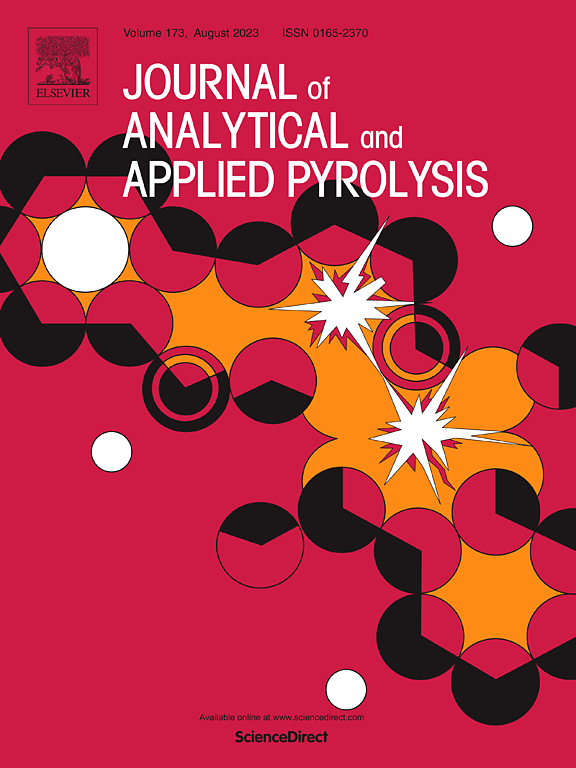PC/ abs共混物的热解化学回收
IF 5.8
2区 化学
Q1 CHEMISTRY, ANALYTICAL
引用次数: 0
摘要
并不是所有的塑料都可以机械回收。聚碳酸酯(PC)与丙烯腈-丁二烯-苯乙烯(ABS)的结合是一种用于电子外壳和汽车部件等应用的材料。由于PC/ABS的机械回收会导致热降解和所需性能的损失,因此需要寻找替代方法。热解,即无氧的热分解,优先裂解某些键,产生有价值的单体。本研究在实验室和中试规模上研究了非阻燃和阻燃PC/ABS共混物的热解过程。分析利用热重法和红外光谱(TG-IR)。受阻燃剂的影响,共混物表现出两个分解阶段。红外光谱提供了对挥发性化合物结构性质的深入了解。CO2产率范围为6 % ~ 8 %,其中阻燃共混物产率提高0.5-1 %。随后,我们在固定床反应器中进行了实验,改变了热解温度、加热速率和混合成分。测量了气体、液体和固体产物的质量,在480-500°C时液体产率最佳。分析了所有产品的馏分。液体产品含有苯酚、苯乙烯和双酚a等有价值的化合物,使用气相色谱(GC)和综合二维气相色谱-质谱法(GC×GC-MS)进行分析。在非阻燃共混物中,双酚a为主要产物(25-30 %),苯酚为主要产物(10-15 %)。本文章由计算机程序翻译,如有差异,请以英文原文为准。
Chemical recycling of PC/ABS-blends by pyrolysis
Not all plastics can be recycled mechanically. Polycarbonate (PC) combined with acrylonitrile butadiene styrene (ABS) is one such material used in applications like electronic casings and automotive components. Since mechanical recycling of PC/ABS results in thermal degradation and the loss of required properties, alternative methods are sought. Pyrolysis, the thermal decomposition without oxygen, preferentially cleaves certain bonds, yielding valuable monomers. This study investigates the pyrolysis of non-flame-retarded and flame-retarded PC/ABS blends at laboratory and pilot plant scales. Analyses utilized thermogravimetry and infrared spectroscopy (TG-IR). The blends exhibited two decomposition stages influenced by flame retardants. The IR spectra provided insights into the structural properties of volatile compounds. CO2 yield ranged from 6 % to 8 %, with the flame-retarded blend showing 0.5–1 % higher yields. Subsequently, we conducted experiments in a fixed-bed reactor, varying the pyrolysis temperature, heating rate, and blend composition. Masses of gaseous, liquid, and solid products were measured, with a liquid yield optimum at 480–500∘C. All product fractions were analyzed. Liquid products contained valuable compounds like phenol, styrene, and bisphenol-A, analyzed using gas chromatography (GC) and comprehensive two-dimensional gas chromatography-mass spectrometry (GC×GC-MS). For the non-flame-retardant blend, bisphenol-A was the main product (25–30 %), while phenol dominated (10–15 %) in the flame-retardant blend.
求助全文
通过发布文献求助,成功后即可免费获取论文全文。
去求助
来源期刊
CiteScore
9.10
自引率
11.70%
发文量
340
审稿时长
44 days
期刊介绍:
The Journal of Analytical and Applied Pyrolysis (JAAP) is devoted to the publication of papers dealing with innovative applications of pyrolysis processes, the characterization of products related to pyrolysis reactions, and investigations of reaction mechanism. To be considered by JAAP, a manuscript should present significant progress in these topics. The novelty must be satisfactorily argued in the cover letter. A manuscript with a cover letter to the editor not addressing the novelty is likely to be rejected without review.

 求助内容:
求助内容: 应助结果提醒方式:
应助结果提醒方式:


